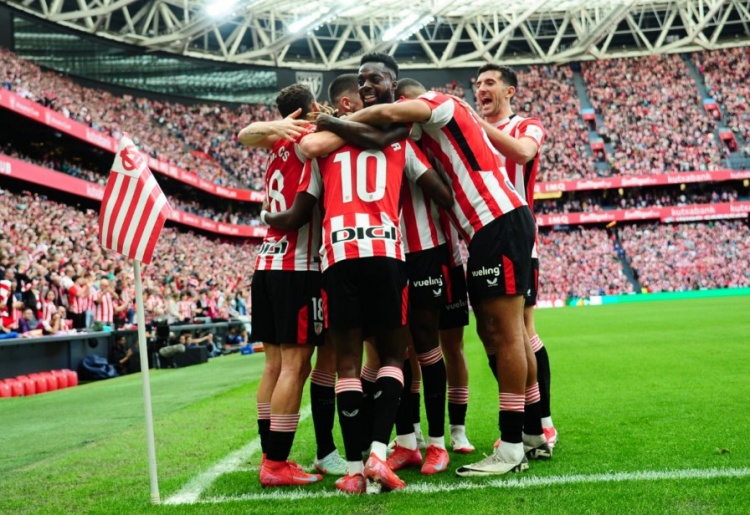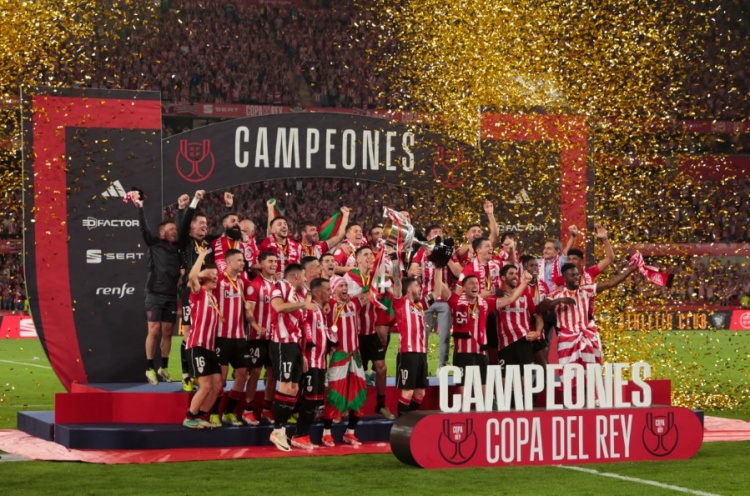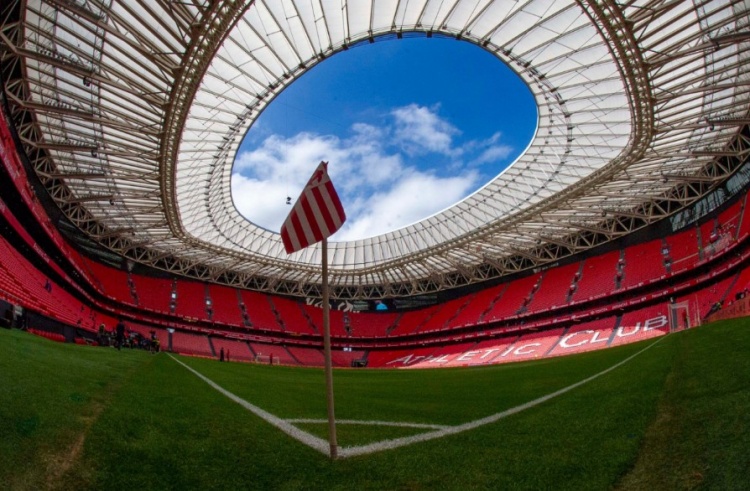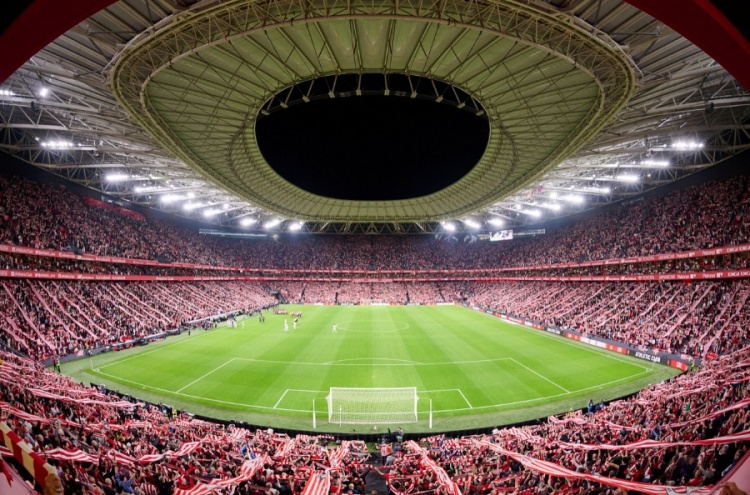XiaSports > Football > Five things you may not know about Athletic Bilbao
Five things you may not know about Athletic Bilbao
From the imported red and white shirts to the Basque player policy, Athletic Bilbao is unique among European football clubs

Founded on July 18, 1898, Athletic Bilbao is one of the oldest football clubs in Europe. The Basque Lions, located in Bilbao, the Basque Autonomous Region of Spain, have the most loyal fan base in Spain. Their home court, San Mames, attracts avid football enthusiasts from all over the world to watch the game. From the unique Basque player policy to the story behind the team's home court, this article will reveal five things you may not know about Athletic Bilbao.
Revealed why Athletic Bilbao wore a red and white jersey, under the influence of British workers and natives returning from Britain, the Basques began to engage in football. Athletic Bilbao originally wore an all-white jersey, but in 1902, before the team competed in the Coronation Cup (the predecessor of the Cup of Kings), Juan Moser, a descendant of the Irish man living in Bilbao, presented the blue and white jersey to the team. Seven years later, the club commissioned player and board member Juan Ellodui to bring back a batch of blue and white jerseys from the UK. But Elloduy, who was in Southampton at the time, could not find the jersey of this color, so he turned his attention to the red and white jerseys worn by the local team. Considering that this color matches the color of the official Bilbao flag, he bought some and took it back to Basque City by ferry. The board approved the change in the jersey color, and it was also since then that Athletic Bilbao has been wearing the iconic red and white jersey.

Basque Player Policy
Athletic Bilbao is proud of itself, and the "Basque Player Policy" they implement has won praise for the team. As early as 1912, the Basque Lions formulated a policy to train and use players born or raised in the Basque Autonomous Region. According to the club's official website, "The club's sports philosophy adheres to a principle, that is, Athletic Bilbao can only use players from its own youth training academy, or players from other club youth training academys affiliated to the Basque Autonomous Region, or players born in relevant regions that make up the Basque Autonomous Region: Biscay, Gipsqua, Arava, Navara, Rabud, Sulai and Lower Navara." This concept is special in European football. Athletic Bilbao has brought the team to an extremely high level of competitive standards by using local players who agree with the club's values (including young players promoted from the famous Lesama Academy).
One of the most successful Spanish clubs
Considering the Basque player policy of Athletic Bilbao, you might think their path to trophy will be difficult. However, Athletic Bilbao is arguably the third successful club in Spain when it comes to winning domestic championship trophy. In fact, only Barcelona won the Copa del Rey more times (32 times) than Athletic Bilbao (24 times), who also topped the La Liga championship eight times (1929/30, 1930/31, 1933/34, 1935/36, 1942/43, 1955/56, 1982/83 and 1983/84 seasons). While the Basque team has achieved such a success, they have never been relegated to the second-tier league. In fact, Athletic Bilbao is one of three teams in La Liga that have never been relegated, with the other two being Real Madrid and Barcelona. The story behind the name of the stadium of Saint Mammes
Athletic Bilbao's home stadium is called Saint Mammes, a name that carries a rich history, and its true origins can be traced back to the martyrdom of Mammes during the Byzantine Empire. Mames was born around 259 AD in Caesarea, Cappadocia, and despite being persecuted and tortured, he is known for his devout Christian faith and charitable acts. Legend has it that he successfully comforted the lions after being thrown to them by the Romans. Mames died in 275 AD, and people's respect for him spread all over the world. In 1447, a temple was built in Bilbao to commemorate him, which later evolved into the San Mames sanctuary, and the adjacent landmark San Mames Stadium was opened in 1913. In fact, the club's home name "San Mames" and the team's nickname "Lion" both originate from the commemoration of this martyr. A new stadium called the Cathedral was also rebuilt on the old site and reopened in 2013. The venue, which can accommodate 53,000 people, has also won multiple awards.

The opponent paid tribute to Pichichi
Raphael Moreno Alanzadi was born in Bilbao on May 23, 1892, in Bilbao, which is known as Pichichi. He has led the team to the Spanish Cup RE: four times and five regional titles. He scored 83 goals in 89 games and was considered one of the most efficient scorers in Spanish football at that time. After Pichichi's death, the club decided to build a statue to commemorate him, which was completed in December 1926. A month later, players from Hungarian team MTK Budapest placed a bouquet in front of the statue before having a friendly match with Athletic Bilbao. Since then, the move has become a tradition, with the captain of the team who first came to San Mames to compete in the game, placing bouquets in front of the statue to pay tribute to the team legend. In memory of him, the Spanish sports newspaper Marca will award the Pichichi trophy to the La Liga top scorer every season since the 1952/53 season.

Related Posts
Bayern official: We have protested to UEFA in response to the temporary restriction order issued by the Paris police on the fans bus
FootballBayern will play a Champions League match against Paris on Tuesday night in an away game. Due to the temporary travel restriction order issued by the Paris police against Bayern fans, Bayern officials expressed dissatisfaction and lodged a protest w...
【Football】
moreKompany: PSG are one of the favorites for the Champions League this season and we are developing in a similar direction to them
FootballAt 4:00 in the morning on November 5th, in the fourth round of the UEFA Champions League, Bayern will play Paris Saint-Germain away. Before the game, Bayern coach Kompany attended the press conference. He talked about some of the team's current s...
【Football】
moreNot for Lao Zhan? For beauty? Ser Radio: Yamal wearing a crown to celebrate may be because of his ex-girlfriend
FootballIn the 11th round of La Liga, Barcelona defeated Elche 3-1. Yamal scored the opening goal for the team. After scoring, Yamal changed his "coronation" celebration this season and turned to biting the Barcelona team emblem on his chest to sh...
【Football】
more
Hot Posts
- Bahrain reporter Golden Ball vote: First Salah, second Ashraf, Dembele fifth
- RMC: The atmosphere in the locker room in Paris is dull until Dembele wins the award and bursts out laughing
- Sky Sports: Sevilla is talking about loan Everton defender Patterson
- Lu Ning responded to the transfer rumors: I have always been very happy in Real Madrid, and of course I hope to stay in the team
- Adriano: He rejected Chelsea for his return to Inter Milan, but his father was unable to focus on playing football after his father passed away
- Player: In addition to Leo, Bayern is also considering introducing Garkebo, and both of them have a transfer fee of more than 70 million euros
- Mbappe completed 7 passes with a 100% success rate, with the most players in the top five leagues this season
- Official: Paris FC signs Real Sociedad right-back H-Traore It is reported that the transfer fee is 4 million euros
- Mid-body: Jurmand is willing to join Juventus, Portuguese demand is too high & Juventus needs to clean D-Luis
- Skira: Rome continues to talk to Verona about Giladi today, and there is a 300,000 euro gap in terms of bonuses
Recent Posts
-
Mijatovic talks about Vinicius: His behavior does not match the spirit of Real Madrid jersey
-
Follow the team: Milan intends to introduce Joe Gomez, Liverpool is hesitant about whether to sell
-
Marseille defender who injured Ronaldo in 2009: I said to him, I m not your son, don t try to fool me
-
RAC1: Bernal wears the No. 22 jersey this season and he is about to get medical license to come back
-
Skira: Naples is preparing to restart negotiations on Endoye, Bologna asks for 40 million euros
-
Italian Football Association Chairman talks about Italy s ranking decline: We must work hard, the only goal is to enter the World Cup
-
Mascherano: DePaul and Messi have an extraordinary understanding, and his joining has improved the team s level
-
Reporter: Chelsea central defender Anselmino is willing to join Dortmund on loan
-
Frick: We are ready for the new season Kubasi is in good condition
-
Reporter: K-Thuram felt discomfort in his left calf muscle during training and will miss this round of Serie A